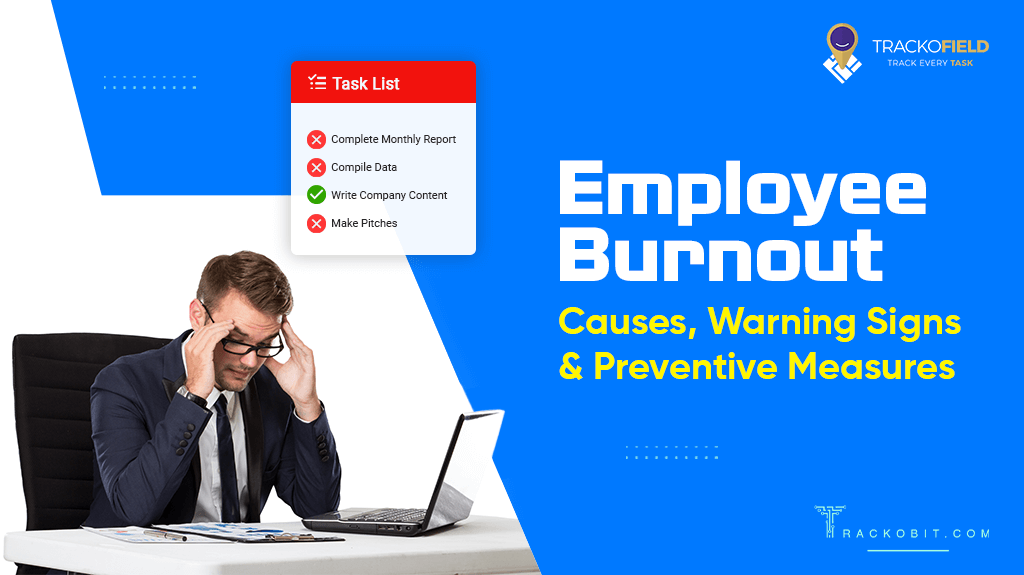-
TrackoBit
Manage commercial vehicles with the new-age Fleet Management Software
TrackoBit -
TrackoField
Streamline your scattered workforce with Field Force Management Software
TrackoField -
Features Resources
-
Blog
Carefully curated articles to update you on industrial trends. -
White Paper
Insightful papers and analysis on essential subject matters. -
Glossary
Explore an alphabetical list of relevant industry terms. -
What’s New
Get TrackoBit & TrackoField monthly updates here. -
Case Study
Explore the cases we solved with our diverse solutions. -
Comparisons
Compare platforms, features, and pricing to find your best fit.
-
About Us
Get to know TrackoBit: our team, ethos, values, and vision. -
Careers
Join the most dynamic cult of coders, creatives and changemakers. -
Tech Support
Learn about our technical support team and services in detail. -
Events
Check out the exhibitions where we left our marks and conquered. -
Contact Us
Connect with us and let us know how we can be of service.
Employee Burnout: Causes, Warning Signs and Preventive Measures
- Author:Tithi Agarwal
- Read Time:5 min
- Published:
Table of Contents
Toggle
With almost 58% of employees getting burned out, know what are prime causes or warning signs. Explore which 10 preventive measures can help preserve employees’ sanity.
Table of Contents
Toggle
Employee Burnout is now nothing less than an epidemic in the current workplaces. Roughly 50% of employees are suffering from burnout.
Workplace burnout is bad for employees and companies as the employees are less productive and increases absenteeism, which can eventually lead to the loss of jobs.
But cheer up because there are ways to prevent employee burnout. Continue reading this blog to identify common causes of employee burnout and ways in which you can prevent it from becoming a bigger problem.
The Silent Culprit – Understanding Employee Burnout
In a very Google-like definition, employee burnout is a state of physical and mental exhaustion usually caused by prolonged stress or frustration. It is linked to high employee turnover, disengagement, depression, and negative feelings toward work and the workplace.
A 2021 study revealed that approximately 17.9 million working days were lost cumulatively due to workplace stress, depression, or anxiety in 2019 and 2020 alone. Furthermore, 50% of work-related illnesses from 2020 to 2021 were caused by burnout.
Workplace burnout is a problem that’s regrettably getting worse with time. A recent Gallup study showed that from 2018 to 2022, active disengagement increased by over 30%.
Unmasking the Causes of Employee Burnout
What causes employee burnout? Is it stress? It could be, but it is not the only reason why your employees are going through their down phase. Let’s unmask some causes.
1. Unmanageable Workload
A Statista survey reported that heavy workloads alone lead to 39% of workplace stress, making it a significant cause of burnout.
It is common for managers to overburden their most efficient employees in order to get more work done faster and more efficiently.
Some of the reasons behind the heavy workload could be
- Fewer employees
- Overburdening skilled employees
- Overestimating the ability of the software
2. High Expectations
Setting higher targets for employees who are not ready and lack skills and bandwidth is another reason for burnout. This might prompt them to stretch out harder, causing them to feel tired and demotivated as they cannot deliver on those expectations.
This will reduce job satisfaction and skyrocket their stress level. Also, unclear and frequent targets and unreasonable deadlines will confuse employees about tasks that have higher priority.
3. Unfair Treatment
Unfair treatment is causing staff burnout and putting a strain on the relationship between managers and employees, thus decreasing employee engagement.
Common unfair treatments include
- Biasness (Priortising favourite employee over deserving one
- Mistreatment (not giving due credit or respect)
- Unjust Policies (not providing a justified and equitable work environment)
- Low Compensation (cutting lesser paychecks than market offerings)
4. Lack of Recognition
Acknowledging and celebrating achievements plays an important role in employee engagement. In fact, organisations that reward and recognise employees’ efforts witness 9% increase in productivity and a 22% decrease in absenteeism.
Not recognising employees will make them feel undervalued and unmotivated, increasing their risk of workplace burnout.
5. Lack of Manager Support
Managers have a direct and significant impact on staff working under them. 34% of workers leave their jobs because of uncaring or uninspiring leaders. In addition, 26% leave because their well-being isn’t prioritized.
Managers play a crucial role in increasing employee engagement. Giving employees someone they can turn to with questions and concerns gives them a greater sense of security and makes it easier to prevent employee burnout.
10 Best Possible Ways to Prevent Employee Burnouts
In an effort to fight workplace burnout from occurring and growing, we have listed some possible ways to prevent burnout.
1. Clear Communication
Employee burnout in a team can be eliminated through fostering open communication. This entails having honest conversations in which team members are comfortable sharing issues, sharing responsibilities, and asking for help. When workers honestly communicate their problems regarding work, cooperative solutions can be provided for reducing stress and averting burnout.
2. Recognise, Appreciate and Reward Often
Engaged workers produce stellar work. Offer incentives and awards for exceptional work, such as praising your sales team for their greatest quarter ever or recognising the customer-facing team for customer acclaim. Timely and genuine acknowledgement makes workers feel appreciated. Don’t keep it a secret: Inform others of accomplishments or significant anniversaries.
Make certain to acknowledge and celebrate the employee as a whole rather than simply their accomplishments. Remember that people are not their jobs.

3. Leverage the Power of Workflow Management Software
Workflow management software is an effective way to prevent employee burnout. The software automates monotonous and tedious work. It is beneficial as it helps:
- Optimally allocate tasks to staff (without burdening).
- Track their daily to monthly routine (to find gaps before time).
- Improve manager-team communication (carving an open and transparent culture).
- Digitises process and workflow (to eliminate pressure and human errors).
Speeds up administrative process An automated task management solution feature help delegate tasks much more effectively, prioritise tasks, promote real-time collaboration, and allocate resources optimally.
Another feature is auto-generated analytical reports, which is great for helping managers detect signs of burnout early on among employees. The reports display real-time productivity and performance data, tasks assigned vs achieved information and other required data for effective employee management. This even promotes the visibility and transparency of the team’s efforts.
4. Put an End to Multitasking
Multitasking is a thing of the past. After all, research indicates that juggling multiple tasks reduces productivity and increases stress levels in people.
In this way, employees lose productivity when they constantly switch between tasks.
One simple way to help would be to advise staff members to “mute” their various communication devices. In this manner, they attentively focus on their tasks instead of letting chimes or bells distract them from their tasks. Employee satisfaction and productivity increase with fewer distractions and switching!
5. Work-Life Balance
Over the last few years, work-life balance has become a very significant subject for workers and companies that must assist in achieving this balance. It is up to them to take the lead in preventing burnout.
Some effective ways to do so:
- No work emailing during the weekend.
- Assign employees tasks while considering their off time.
- Self-care days allow people to give themselves some “ME” time.
- An expectation that responses come in quality, not in time.
6. Reduce the Workload
Organisations can take action to minimise employee burnout by routinely assessing staff workloads and ensuring that they have reasonable responsibilities and realistic deadlines. This could mean:
- Moving around team members’ responsibilities
- Adding more staff when needed
- Or adjusting project schedules.
Establishing reasonable goals and avoiding excessive workloads can help organizations reduce the risk of burnout and promote a healthy work environment.
7. Provide Autonomy
Employees are more likely to love their jobs when they have some degree of autonomy. They can handle their work in ways that optimise their efficiency if given some freedom. For instance, managers can confer with their staff before assigning project deadlines. This independence can lessen fatigue brought on by unrealistic deadlines.

8. Flexible Work
In flexible working conditions, employees can choose the number of hours they work each week and the time and location of their employment. They now have greater flexibility to take breaks, leave early, and work from home. Team members don’t have to sacrifice because flexible work enables them to effortlessly balance work and life.
Flexible work arrangements help reduce employee burnout by giving workers control over their lives and empowering them to live their best lives and produce their best work. Moreover, it lessens tension, boosts spirits and output.
9. Providing Frequent and Actionable Feedback
To prevent burnout at work, managers must regularly meet one-on-one with their direct reports to solicit and provide feedback. In addition to strengthening the bond between managers and staff, this gives people a private platform to discuss their problems. Give employees constructive criticism so they can grow and develop in their positions. Positive reinforcement and constructive criticism both increase engagement.
10. Prioritising Wellness and Mental Health
An estimated $300 billion is spent annually on the psychological and physical expenses of employee burnout as a result of things like employee turnover, accidents, reduced productivity, and absenteeism. It can be challenging to strike a work-life balance, particularly for remote workers, because their home and work lives often collide.
As needed, remind employees to direct reports to take time for themselves. Remember that every person is different and will need different kinds of assistance to maintain their physical and emotional well-being.
Warning Signs of Employee Burnout
You can prevent employee burnout but must address the underlying causes and break bad work habits. Management should be made aware of the symptoms of employee burnout in order to recognise them early.
✅An increase in irritability or conflict
✅ A pessimistic outlook or marked lack of interest
✅ Decreased productivity or quality of work
✅ Fatigue or exhaustion
✅ Restlessness or insomnia
✅ Increase in physical illness or discomfort
✅ Mental health concerns such as anxiety and depression
✅ Isolation or avoidance in the workplace
✅ Decision fatigue
✅ Concentration or memory issues
Conclusions
“We had been bought into the delusion that burnout is the price we pay for success” – Ariana Huffington
Employees are a valuable asset for the companies, and prioritising their well-being is a must. They are already under the stress of delivering good quality work, and an additional heavy workload can push them off the tipping point.
Employee burnout can be prevented by monitoring their performance, cultivating a healthy working culture and undertaking preventive measures. Companies can use the tips we have covered here to tackle workplace burnout.
Employee monitoring software like TrackoField comes in handy in such times as it can help managers detect early signs of burnout through its real-time reports and task monitoring solution.
Frequently Asked Questions
-
How do you overcome employee burnout?
We can prevent employee burnout by prioritising work-life balance, offering regular breaks for recuperation, promoting flexible work arrangements, conducting enjoyable activities for staff engagement, and other measures.
-
Why should organisations care about employee burnout?
Employee burnout lowers workplace productivity and service quality because burned-out workers are more prone to make mistakes. For this reason, companies ought to be concerned about worker burnout.
Tithi Agarwal is an established content marketing specialist with years of experience in Telematics and the SaaS domain. With a strong background in literature and industrial expertise in technical wr... Read More
Related Blogs
-

Loan Disbursement in NBFCs: From 15 Days to 3 Minutes – Learn How
Shemanti Ghosh December 11, 2025TrackoField’s AI-enabled field force automation software speeds up loan disbursals in NBFC with field agent task monitoring and facial attendance…
-

AI Facial Recognition Attendance: A Game-Changer for Fraud-Free Field Operations
Mudit Chhikara December 9, 2025Ensure transparent attendance and eliminate fraud before it even starts with AI facial recognition and geofencing.
-

Boost Agri-Input Sales Efficiency with TrackoField’s Sales Order Management Module
Shemanti Ghosh December 3, 2025Grow Agri-input sales and expand farmer database with TrackoField’s Sales Order Management module.
-

Tired of Fake Field Visits in your MFIs? Face AI Attendance Can Help
Mudit Chhikara November 5, 2025How Face AI Attendance can help end fake field visits in MFIs for good.

Subscribe for weekly strategies to boost field team productivity.
Your inbox awaits a welcome email. Stay tuned for the latest blog updates & expert insights.
"While you're here, dive into some more reads or grab quick bites from our social platforms!"Stay Updated on tech, telematics and mobility. Don't miss out on the latest in the industry.
We use cookies to enhance and personalize your browsing experience. By continuing to use our website, you agree to our Privacy Policy.



































